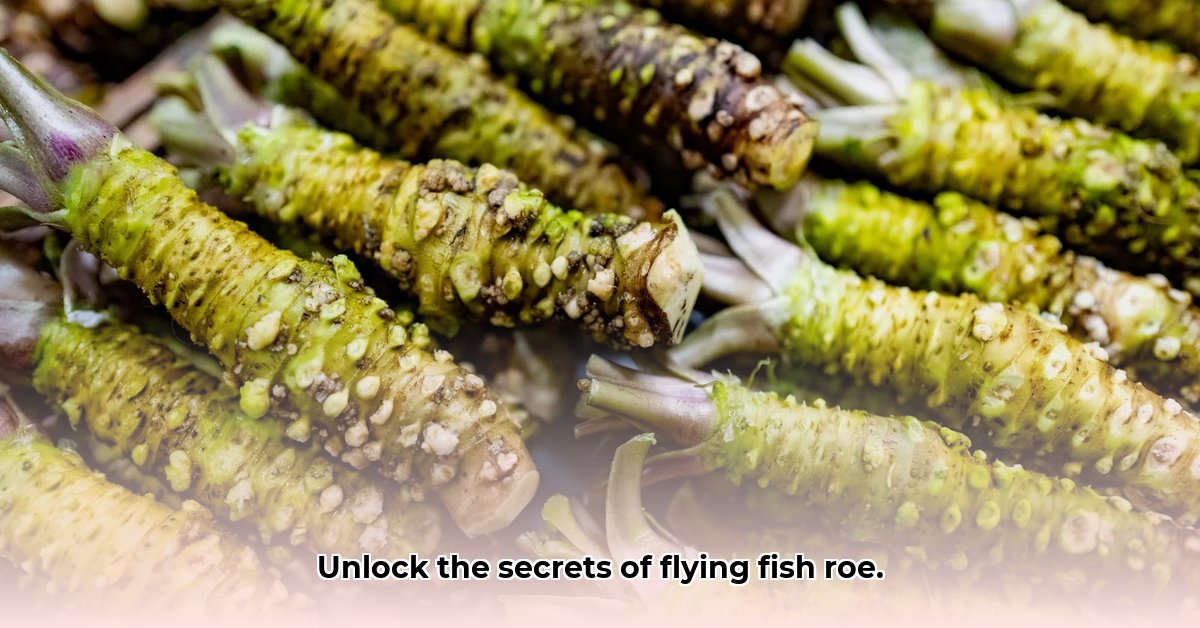Have you ever wondered what that vibrant burst of color and flavor is on your sushi? It’s likely tobiko – the roe of the flying fish! But tobiko is just the beginning of the fascinating world of Japanese fish roe. This comprehensive guide will take you on a delectable journey, exploring tobiko’s unique characteristics and contrasting it with other popular roe like masago, ikura, and kazunoko. We’ll delve into the nuances of their textures, tastes, and common uses in Japanese cuisine, from traditional dishes to modern creations. We’ll also uncover the cultural significance of these tiny treasures and provide you with the knowledge to select the highest-quality roe for your culinary adventures. Prepare to become a true connoisseur of Japanese fish roe!
Diving Deep into Flying Fish Roe: Tobiko and Its Distinguished Relatives
Let’s embark on an exploration of the captivating realm of Japanese fish roe, commencing with the star attraction: tobiko, the esteemed flying fish roe. This is not merely any fish egg; it’s a miniature jewel possessing a bold character. Its brilliant orange-red hue is visually captivating, and its delightful crunch imparts a gratifying sensation to any dish. Envision it as the minuscule, flavorful confetti of the culinary world. What qualities distinguish tobiko from other types of caviar and roe available?
Savoring the Essence: Flavor and Texture Nuances of Tobiko
Tobiko’s distinctive texture arises from its relatively generous size – imagine minute spheres, spanning roughly 0.5 to 0.8 millimeters in diameter. This characteristic sets it apart from its roe counterparts. The flavor profile embodies a harmonious equilibrium between sweetness and saltiness, punctuated by a subtle briny undertone that enhances a plethora of dishes. However, the majority of commercially available tobiko undergoes a degree of processing. Producers frequently incorporate elements such as sake vinegar, mirin (a sweet Japanese rice wine), and dashi (a Japanese soup stock) to intensify its flavor and prolong its shelf life. These supplementary components contribute to the overall gustatory experience, culminating in a more sophisticated profile. And the range of colors – black, green, or yellow tobiko – are usually the result of adding natural or artificial food coloring, enhancing the visual appeal.
Masago: Tobiko’s Accessible Counterpart – A Taste and Texture Comparison
Now, let’s delve into masago, frequently presented as a more economical substitute for tobiko. Masago is primarily derived from capelin roe, sourced from a smaller fish species. Its affordability renders it a favored option for restaurateurs and home cooks alike, seeking a budget-conscious alternative. The primary distinction resides in the texture: masago boasts a significantly softer, more delicate mouthfeel when contrasted with tobiko’s delightful crunch. Masago is also smaller in size. While both share a salty essence, masago frequently lacks the subtle sweetness that characterizes tobiko, and is often dyed to simulate tobiko’s vibrant coloration.
Expanding Horizons: Beyond Tobiko and Masago – A Panorama of Japanese Fish Roe
Japan’s culinary heritage boasts a diverse array of fish roe, each endowed with distinctive attributes and culinary applications. Let’s examine some other prominent choices:
| Roe Type | Fish Source | Texture | Flavor Profile | Common Uses |
|---|---|---|---|---|
| Tobiko | Flying Fish | Crunchy | Sweet & salty, subtly briny | Sushi, garnishes, appetizers, California rolls |
| Masago | Capelin | Soft | Salty, mild | Sushi, salads, pasta dishes, imitation crab dishes |
| Ikura | Salmon | Soft, Bursting | Rich & savory, slightly sweet | Sushi, rice bowls (donburi), hand rolls, sashimi |
| Kazunoko | Herring | Firm, Crunchy | Savory, subtly sweet & salty | Osechi Ryori (New Year’s dishes), appetizers, often marinated in dashi and soy sauce |
| Tarako | Cod | Soft, Creamy | Salty, savory | Onigiri (rice balls), pasta dishes, rice bowls, fillings |
| Mentaiko | Cod | Soft, Creamy | Spicy, salty, savory | Rice bowls, pasta dishes, as a spread on crackers, fillings, sauces |
| Uni | Sea Urchin | Creamy, Melty | Rich, briny, umami | Sushi, sashimi, pasta, sauces |
| Karasumi | Mullet | Chewy, Dense | Intense Umami, Salty, Bold | Sliced thinly as an appetizer, grated over pasta, used in salads |
Assessing the Nutritional Landscape of Fish Eggs: A Perspective
Fish roe presents a surprisingly nutritious profile, typically abundant in protein and omega-3 fatty acids. It’s also a good source of vitamins, including B12 and D. However, the sodium content can fluctuate depending on the roe type and processing. Some varieties possess inherent saltiness, while processing techniques may elevate sodium levels further. While fish roe offers health benefits, moderation is key, especially for those monitoring sodium intake. Always consult the nutrition label for specific sodium values. How does the nutritional value of fish roe compare to other common sushi ingredients like avocado or tuna?
Cultural Resonance: More Than a Mere Topping
In Japan, fish roe transcends its culinary role, imbued with profound cultural significance. Kazunoko (herring roe), for instance, graces traditional New Year’s feasts, symbolizing fertility and prosperity, reflecting a rich cultural tapestry that elevates these culinary treasures. Are there other Japanese foods that also carry symbolic weight similar to kazunoko?
Culinary Explorations: Unleashing the Potential of Fish Roe
The adaptability of Japanese fish roe is truly remarkable. Envision the delightful crunch of tobiko elevating a simple sushi preparation, or the lavishly rich, bursting profile of ikura adding luxury to a rice bowl. Each type bestows a distinct textural and flavor profile, opening up a realm of culinary possibilities. The ongoing exploration of flavor combinations and culinary applications promises continued intrigue and delight among food enthusiasts.
- Tobiko provides a unique crunch and subtle, salty-sweet flavor for enhancing the dining experience.
- Frequently enhanced with natural pigments, like squid ink, for visual appeal, improving dish presentation.
- Sustainable sourcing is crucial because of potential overfishing concerns. Selecting tobiko from responsible sources can help with preserving the future.
Deciphering Tobiko and Masago: A Nutritional Perspective
Let’s venture into the realm of Japanese fish roe, spotlighting two cherished varieties: tobiko and masago. Understanding their nuances unlocks the secrets to their distinct culinary roles.
Tobiko: Jewel of the Flying Fish – Unveiling Flavor and Processing
Tobiko, derived from the flying fish, is celebrated for its vibrant orange tint and distinctive “pop.” This satisfying texture stems from a larger size and firmer consistency. Its flavor strikes a sweet balance, with subtle ocean notes. Preparation typically involves minimal processing, often brining with salt, which helps preserve the roe’s inherent qualities.
Masago: The Versatile Capelin Roe – An Economical Alternative
Masago, from capelin, offers an accessible alternative. Smaller and softer than tobiko, its natural color is a paler orange or yellow, often enhanced to mimic tobiko. The taste is relatively milder, yet offers an appealing saltiness.
Nutritional Showdown: Tobiko vs. Masago
While both roe are nutritious, subtle differences exist. Masago typically contains slightly fewer calories and less fat than tobiko. Though the variation in nutritional profiles is minor, both additions are considered healthy. Always remember to check food labels for exact values and to be mindful of sodium intake. What specific processing methods contribute the most to increased sodium levels in fish roe?
Beyond the Basics: A Glimpse at Other Japanese Roe Varieties
Japanese cuisine extends beyond tobiko and masago, featuring a diverse selection of fish roe delicacies.
- Ikura (Salmon Roe): Prized for its sweet burst and larger size.
- Kazunoko (Herring Roe): Symbolizing fertility, it’s often enjoyed during New Year’s celebrations.
- Tarako (Cod Roe): Salted and seasoned, it’s a staple ingredient in pasta and rice dishes.
- Mentaiko (Spicy Cod Roe): A flavorful option, produced with a chili-based marinade.
- Your Perfect Bento Box Bag For Fresh And Tidy Meals - December 2, 2025
- Korean Meal Prep Made Easy For Delicious Weekday Meals - December 1, 2025
- Korean Food Meal Prep Makes Flavorful Weekday Meals Simple - November 30, 2025










